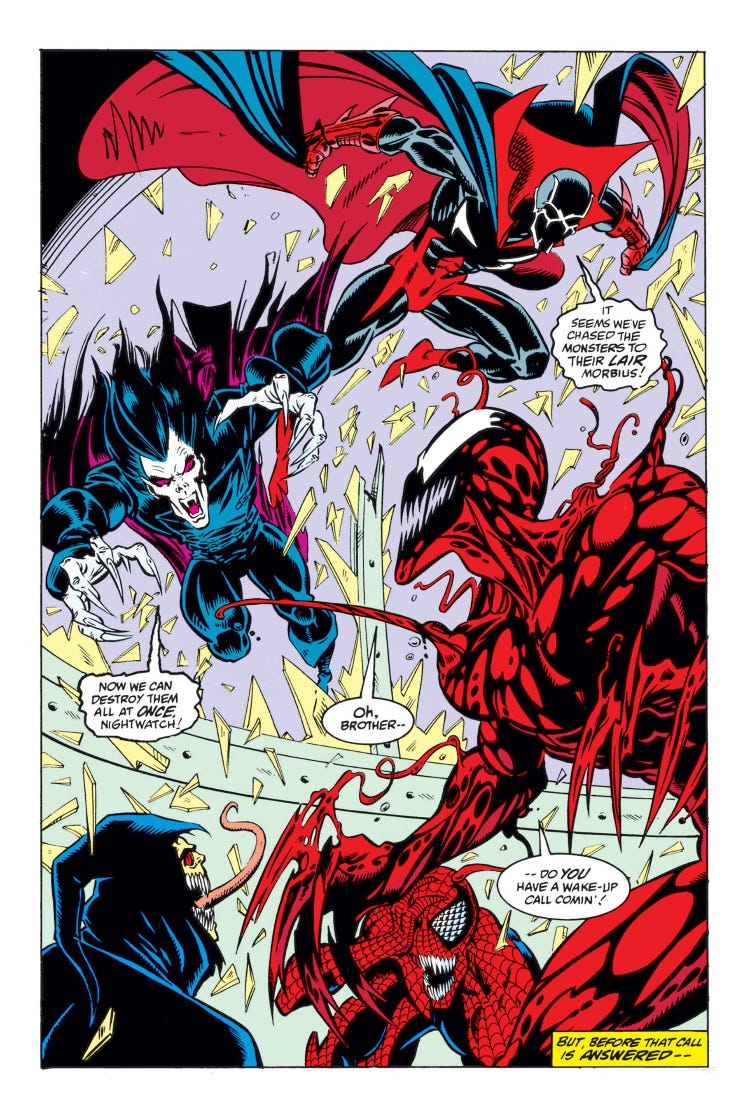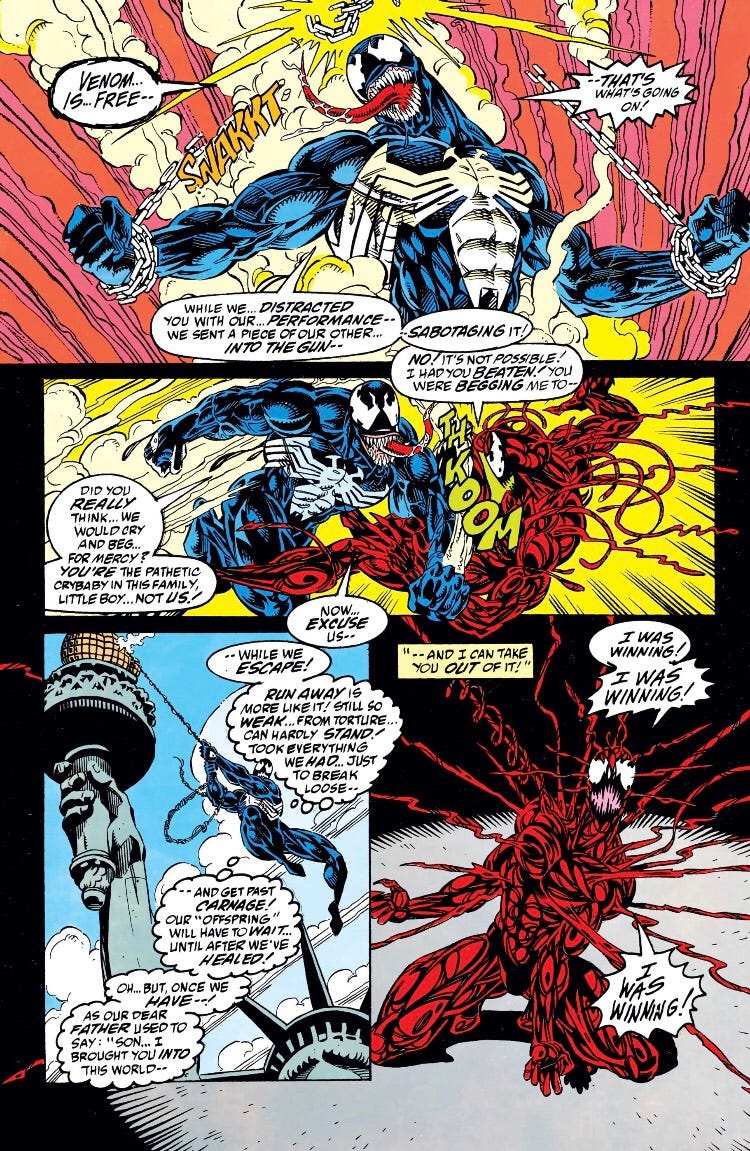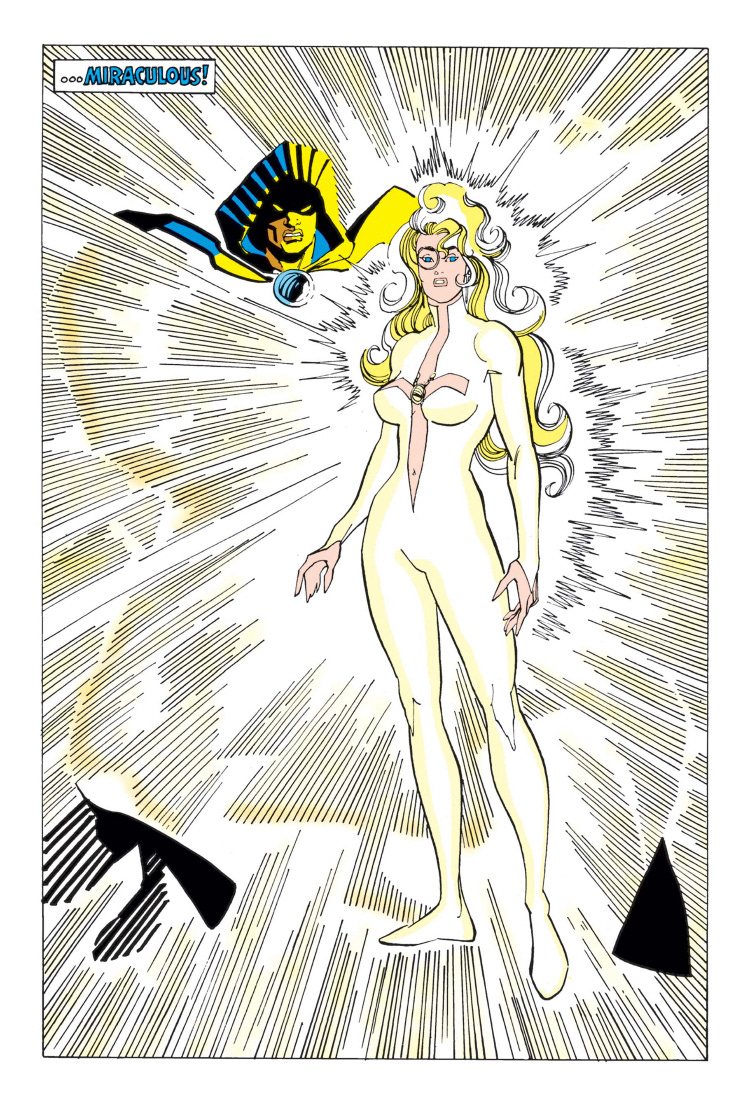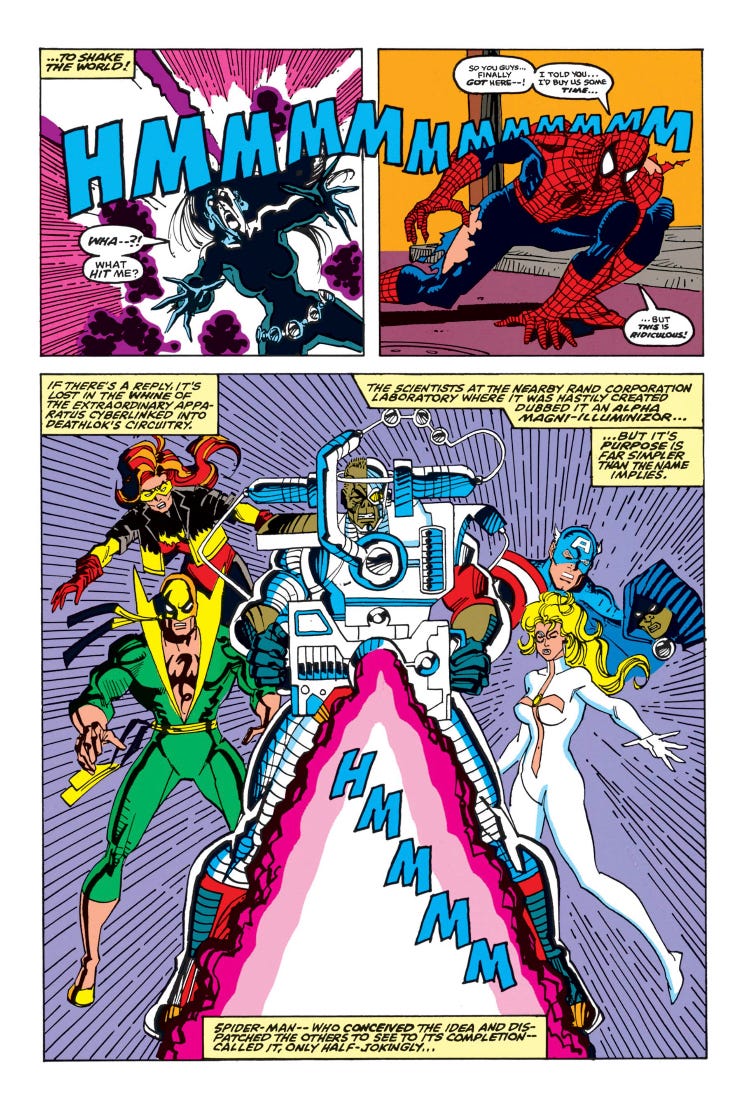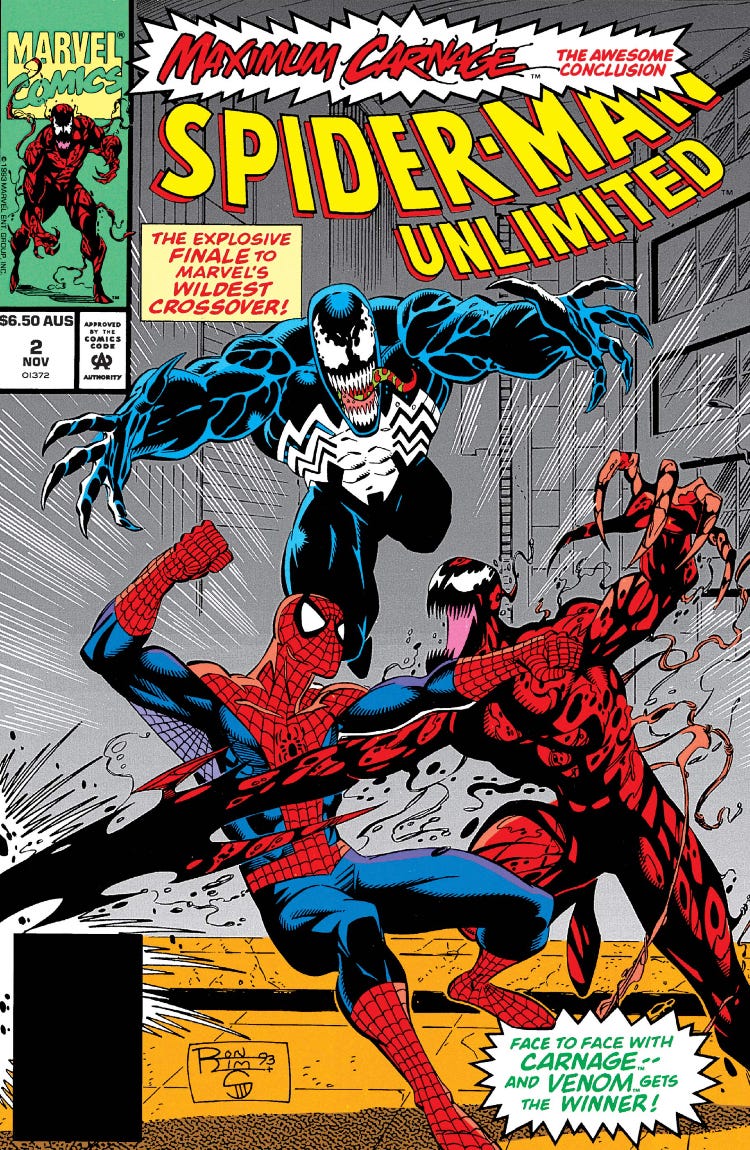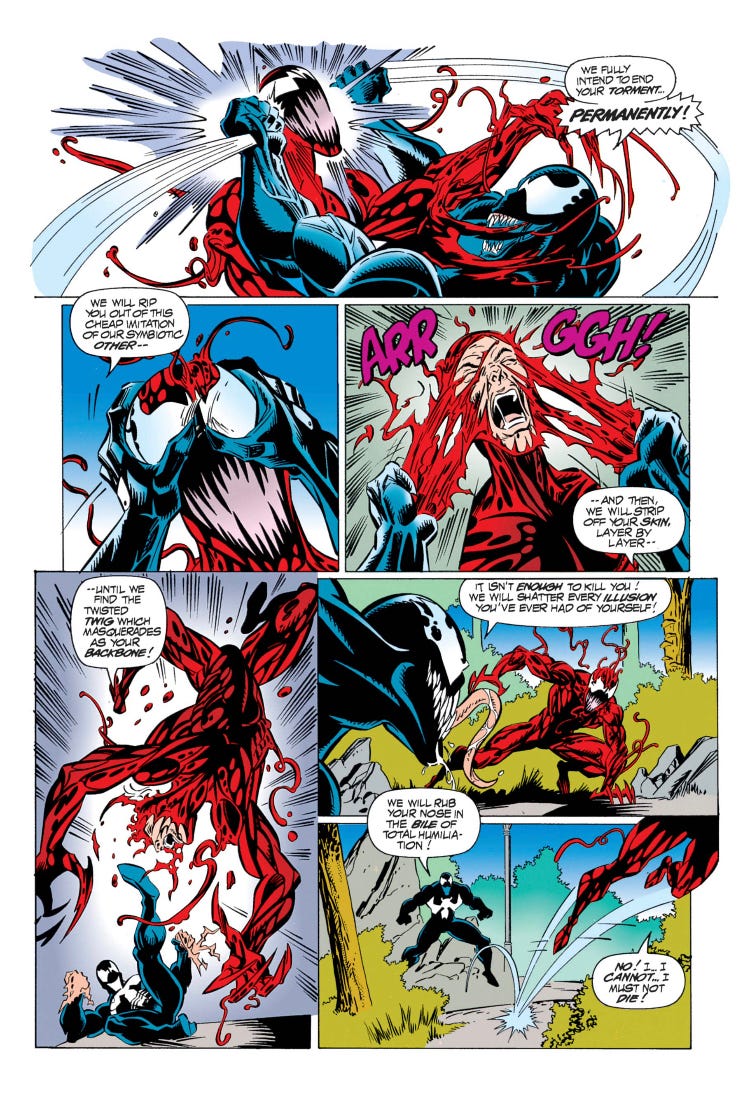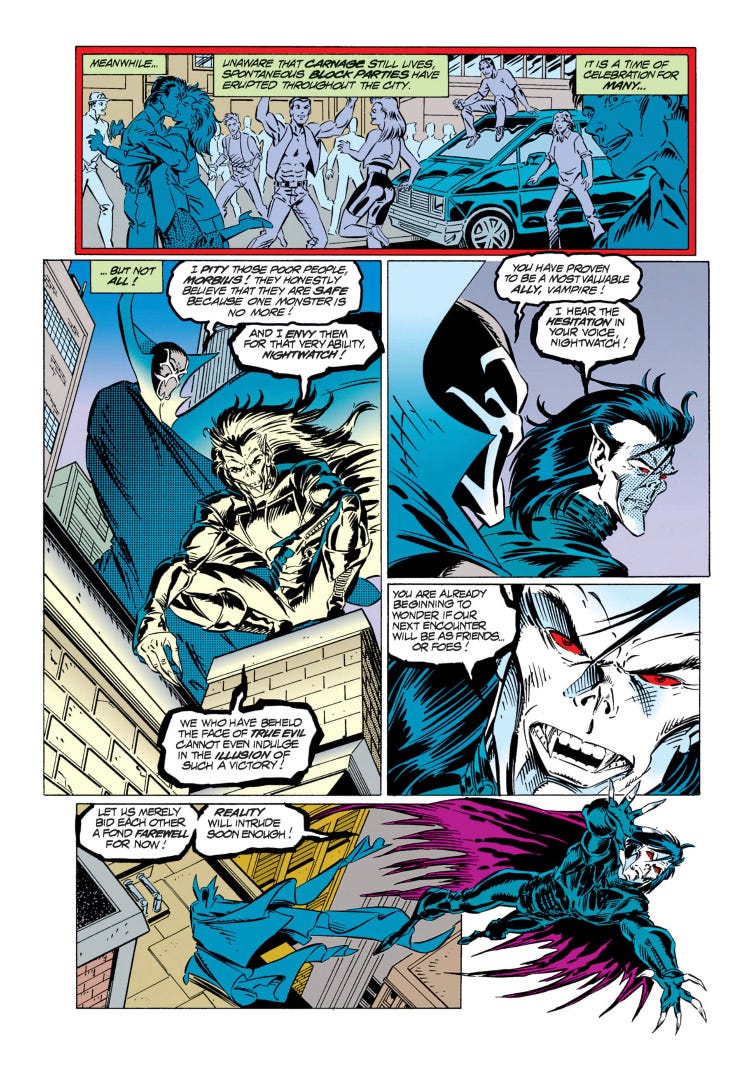Revisiting “Maximum Carnage” Part 4
Part IV: Love Gun
You may have noticed that we’re on the fourth part of this retrospective series on “Maximum Carnage,” and there has yet to be a piece devoted to the actual story. Part of that is because the narrative thrust of the first two acts is the recruitment of heroes, antiheroes, and villains by the two competing groups as they engage in pitched battles and skirmishes across New York City. It’s really Amazing Spider-Man #380 (Part 11) by David Michelinie and Mark Bagley when all of the protagonists and antagonists are firmly in place and the final stages of the conflict begin.
The issue picks up with Morbius and Nightwatch pursuing Demogoblin and Doppelgänger to their home base inside the Statue of Liberty where Carnage currently resides. He’s been busy torturing his “father” (Venom) by suspending him in chains above a small fire. Pretty cruel stuff.
Morbius and Nightwatch seem to think they can end this conflict once and for all by defeating Carnage, Demogoblin, Doppelgänger, and Carrion all by themselves. Bold strategy! I’m sure that will go smoothly.
Meanwhile, our second group of heroes composed of Spider-Man, Captain America, Firestar, Iron Fist, and Deathlok are searching for the source of the madness that is gripping the city. They quickly realize that Shriek is the one responsible, and she’s currently operating on her own while the rest of her “family” are busy defending against the attack from Morbius and Nightwatch. She puts up a better than expected fight before succumbing to her one weakness: getting drilled in the back by a large metal shield.

Speaking of folks putting up a better than expected fight, Morbius and Nightwatch are doing a pretty decent job despite being outnumbered. It probably helps that Carnage is content to just sit back and watch the fight for his own amusement while his “children” do all of the heavy lifting. Eventually the Sun begins to emerge as the fight rages on into the early morning. This is decidedly bad news for our antiheroes as it puts Morbius out of commission. Nightwatch, realizing his current predicament, grabs the barely conscious Morbius and makes a hasty retreat. It would appear their plan to score a decisive victory was less than successful. A positively delighted Carnage sends his “children” to go find their “mother” while he gets back to the important business of brutally torturing Venom.
Spider-Man and his (amazing) friends are working diligently to deescalate the violence gripping the city now that Shriek has been subdued. We get some nice moments of the heroes convincing civilians to calm down and get back to their senses. This is quickly interrupted when Demogoblin and Doppelgänger show up to rescue Shriek. The heroes turn their attention to fighting the trio of villains as we’re treated to a few panels of Black Cat and Cloak both on their own contemplating what they should be doing to help (Black Cat because she was nearly killed, and Cloak because he feels lost without Dagger).
With the villains outnumbered and on the ropes, Shriek decides to put everything she has into one massive psychosonic blast to push the citizens of New York City into a full blown homicidal rage. The issue concludes with the heroes now realizing that they have an entire city with its sights set on killing them. Not great!
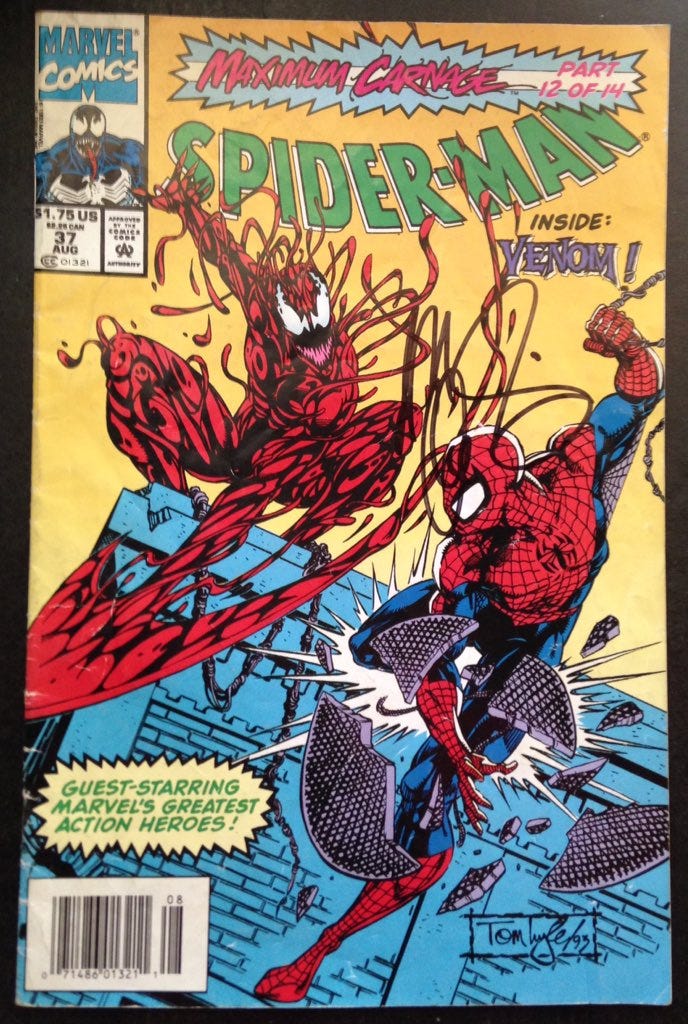
The story continues in Spider-Man #37 by J.M. DeMatteis and Tom Lyle. This issue holds some special significance for me as it’s the first comic book I ever bought as a kid. It is not lost on me that the comic that set me on the path of becoming a lifelong fan was the twelfth part of a fourteen issue crossover with a bunch of characters I had never even heard of up to that point outside of Spider-Man, Venom, and Captain America.
The issue picks up with the heroes doing their best to get the citizens of New York City to mellow out, but it is not going super well. Meanwhile, Carnage continues torturing Venom until he can get him to beg him to just kill him. Carnage assures him that he’s going to continue torturing him for weeks before he finally kills him because he’s truly the worst person ever. He does decide that he might as well kill Eddie’s symbiote though with a blast from the sonic gun that the heroes had previously snatched from the Fantastic Four; however, it turns out Venom had been counting on this. He had been using his symbiote’s tendrils to sabotage the gun while Carnage was distracted, and the end result is that the gun merely coats Eddie with even more symbiote. I’m not entirely sure what the science is behind this, but it succeeds in giving Venom enough strength to break free and escape. This makes Carnage very sad.
Meanwhile, Shriek and her children are enjoying watching their adversaries have to deal with an entire city trying to murder them. Iron Fist tries to harness his chi to calm down the crowd, but it is only mildly successful. While this is happening, Shriek laments that she is tired of waiting for Carnage to join up with them to continue on their murder spree. She tells the kids that it’s time to hit the road and get back to killing people. She could not have timed this more poorly as Carnage happens to show up just in time to hear her say this. He was already in a bad mood from Venom escaping earlier, and now he’s positively livid that his gal pal would go on a murder spree without him. He responds as any mass murdering piece of garbage would in such a situation and promptly grabs Shriek and slams her head into the roof that they are standing on. This prompts Doppelgänger to go into protective mode and attempt to rescue his “mother” by webbing Carnage around his throat and choking him. While this was a pretty noble act from the creature, Doppelgänger is simply not in the same league as Carnage. Carnage promptly thrashes and mocks Doppelgänger before punting him off the roof of the building to crash to his death on the street below. Brutal.
The villains seem set on killing each other until they realize that all of the civilians are gone with only the heroes left in the streets. It turns out Shriek’s control over the masses dissipated when she was being pummeled by Carnage. Whoopsie! With one of their crew now dead and only the heroes remaining, the Carnage Crew decides to put aside their squabbles and turn their attention back to killing the heroes. Before the fisticuffs begin, both sides are shocked to see that Cloak has rejoined the fight with the previously thought dead Dagger!
The penultimate chapter in the story takes place in Spectacular Spider-Man #203. This also serves as the final issue of the J.M. DeMatteis and Sal Buscema run on the title. Dagger has seemingly returned from the grave to assist our heroes in their final battle with Carnage and his family. Turns out she had been transformed into pure light and was just floating around in the Dark Dimension contained within Cloak’s cloak recovering. Shriek does not take this news well. At all. Shriek launches into a murderous rage attempting to kill Dagger for a second time since it didn’t take the first time, and she fails once more. After a quick fight, Carnage swoops in to gloat about his “wife” not being able to get the job done without him. Following their little family discussion, Carnage is shocked to realize that all of the heroes have disappeared other than Spider-Man. Spider-Man vows to put them all down himself and gets into one of the most lopsided fights in his career as he tries to bring down four of his most powerful villains at once. He fights valiantly, but he is obviously no match for these villains without any assistance. Before Carnage can deliver the killing blow, Spider-Man’s allies show up with a Deus Ex Machina in the form of a secret weapon called an alpha magni-illuminator. You’re probably wondering what the hell that is. Spider-Man refers to it as “Good Bomb,” but I think it is better described as a “Love Gun” (although I’m sure Gene Simmons would have demanded royalties if they went with that name).
Basically it’s a weapon that functions as the exact opposite of Shriek’s murder waves and fills a person’s brain with positivity. The weapon successfully mellows out Shriek, cures Carrion of his condition, and renders Demogoblin unconscious. Things don’t go as smoothly with Carnage. The dude is so evil that he resists the weapon’s effects to the point that it causes a massive explosion that seemingly kills him. In the smoldering ruins of the explosion rests Carnage’s corpse. He’s completely nude except for his face which is somehow still coated with symbiote. How humiliating. Spider-Man is devastated that he wasn’t able to stop Carnage without killing him, but the other heroes assured him that they all did everything possible to save the day without any casualties (except for the seemingly hundreds of people killed during the course of this event). Spider-Man sits alone in Central Park at the end of the issue as he reflects on what has happened. That contemplation is interrupted when Venom (still weakened from being tortured) shows up furious that he didn’t get to kill Carnage himself. What a guy! Before Spider-Man can say anything to cheer him up, Carnage pops up alive and well!
The final chapter of this event takes place in Spider-Man Unlimited #2 written by Tom DeFalco with art by Mark Bagley (the first half) and Ron Lim (the second half). We quickly learn that Carnage tricked the heroes into thinking he was dead by putting some of his symbiote on the face of the corpse of some random person he killed. Clearly the filmmakers responsible for Halloween Resurrection read this comic. You know who else read this comic? Me as a child. Repeatedly. This issue could not be more simple. Though Carnage survived the “Love Gun,” it did weaken him significantly. He’s a shell of his normal self and dealing with a level of psychosis that even he isn’t able to handle. Because of this, Venom takes the opportunity to savagely beat him throughout the entirety of this oversized issue. As a massive fan of Venom as a child (and also still today as an adult), this was incredibly satisfying to read. Spider-Man attempts to act as referee to prevent Venom from outright murdering Carnage, and Venom thanks him by breaking his ribs on the other side of his body. Ouch.
While that’s going on, we get to see Morbius and Nightwatch have a quick philosophical discussion about the nature of heroism and responsibility. I don’t know why, but I find it very funny that those are the two characters who get to have this conversation instead of any of the more established characters.
I had mentioned previously that Bagley is the artist for the first half of the issue while Lim handles the second half. I’m not sure if that was done in order to hit deadlines or if it was done for creative purposes, but I really enjoy seeing both artists get a crack at it. They are probably the two artists most associated with drawing Venom at this time (both worked on Venom’s debut solo series called Venom: Lethal Protector that came out earlier that same year).
While battling each other throughout the issue, our three primary characters end up at a cemetery for the final act. Carnage ends up in a position to potentially score a kill shot on Spider-Man, but Black Cat arrives just in time to save him (she had been grappling with her own mortality and was unsure if she rejoin the fight in the previous couple of issues). As the fight continues, Carnage finally begins to recover and begin acting like his normal self. Fearing the tide may turn, Venom tackles Carnage into some generators that cause a massive explosion that puts down Carnage. Venom manages to survive and sneaks away while the Avengers finally show up to take Carnage into custody. To further underscore just how pathetic the Avengers were at this time, Black Cat comments that she could easily make the roster considering the characters currently on the team. Savage.
Thus concludes the “Maximum Carnage” event. It leaves behind an interesting legacy. It’s a perfect snapshot of where the comic book industry was at the time. It highlights the more extreme and disturbing villains that had become popular at the time, and it allows the far more violent and extreme antiheroes of the time to take center stage. It also gives the writers of the time an opportunity to show why traditional heroes like Spider-Man and Captain America are ultimately more effective and enviable than the more savage newcomers. It also helped popularize comics among the wider population with the video game adaptation. It definitely has some issues due to being unnecessarily long and interrupting the stories the creators were currently telling prior to the start of the event, but it’s still a fun read. I might not be a comic book fan without it. That’s good enough for me to remember it fondly.


